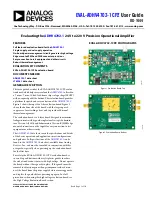
EVAL-ADHV4702-1CPZ
User Guide
UG-1444
Rev. 0 | Page 3 of 10
EVALUATION BOARD HARDWARE
BOARD STACKUP
The EVAL-ADHV4702-1CPZ evaluation board is a 6-layer
board. The signal routings are on Layer 1 (top) and Layer 4. The
bottom layer is an exposed copper ground plane used for heat
dissipation and heat sink attachment. Internal Layer 2 through
Layer 5 are the VCC, VMID, signal, and VEE planes,
respectively.
The EVAL-ADHV4702-1CPZ evaluation board is divided into
two sections as shown in Figure 3. The upper section is the test
circuit for the
ADHV4702-1
, and the lower section is the
optional on-board power management circuit comprising an
LT8304-1
monolithic micropower isolated flyback converter. The
connection of these two sections can be made via the P1, P4,
and P5 connectors. Refer to the Initial Power-Up section for
more information.
ADHV4702-1 TEST CIRCUIT
LT8304-1 POWER MANAGEMENT CIRCUIT
17224-
003
Figure 3. Evaluation Board Test and Power Management Circuits
INITIAL POWER-UP
The EVAL-ADHV4702-1CPZ evaluation board is shipped for
use with dual symmetrical power supplies. Before applying
power to the board, apply the jumper from the VMID node to
the AGND node (see Figure 4) via P2, using the 2-pin header, to
provide a dc operating point for the amplifier.
The EVAL-ADHV4702-1CPZ evaluation board can be powered
up using the external power supply or the on-board
LT8304-1
power management circuit. To power up the board using an
external power supply, apply the power at the PWR header or
via the GND, VCC, and VEE test points. The quiescent supply
current is approximately 3 mA. In addition to the quiescent
current, there is an additional ~2.2 mA from the VCC supply to
bias the D1 Zener diode clamp at the SDN connector.
The
LT8304-1
on-board power management circuit can be used
to provide dual supplies of approximately ±110 V from a
convenient 15 V dc input. Apply 15 V dc from an external
power supply at the VIN_15V test point or by using a 15 V dc
wall transformer type plugin at P6. Connect the outputs from
the on-board power management circuit to the
ADHV4702-1
test circuit via the P1, P4, and P5 connectors. For ±110 V dual
supplies, jump VCC_TRANSFORMER to VCC, VEE_
TRANSFORMER to VEE, and GND_TRANSFORMER to
AGND. The
LT8304-1
on-board power management circuit can
also provide a single supply of 220 V. The schematic for the
on-board power management circuit is shown in Figure 5. For
more information, refer to the
LT8304-1
data sheet for different
voltage output options.
POWER SUPPLIES AND DECOUPLING
The EVAL-ADHV4702-1CPZ evaluation board can be powered
using a single supply or dual supplies. The total supply voltage
(VCC − VEE) must be between 24 V and 220 V. When using a
single supply or asymmetrical dual supplies, apply the appropriate
reference voltage to the VMID pin of P2 using a low impedance
source, such as a dc power supply. The recommended VMID
reference voltage is (VCC + VEE)/2.
The EVAL-ADHV4702-1CPZ board provides sufficient power
supply decoupling for fast slewing signals with 1.2 µF (C1, C2),
250 V ceramic chip capacitors where the supply voltage enters
the board. Two 0.1 µF, 250 V ceramic chip capacitors (C3, C5)
are placed in close proximity to VCC at Pin 7. Two capacitors
(C4, C6) are placed in close proximity to VEE at Pin 4.
INPUT AND OUTPUT
Figure 4 and Figure 5 show the evaluation board schematics for
the factory default settings. The evaluation board uses edge
mount SMA connectors on the inputs and outputs for easy
interfacing to signal sources and test equipment. In addition,
the board accepts SMB connectors on the inputs for efficient
connection to other circuitry such as the
EVAL-AD5754REBZ
DAC evaluation board.
The EVAL-ADHV4702-1CPZ evaluation board is equipped
with 49.9 Ω termination resistors at R1 and R2. The power
rating of the termination resistors is 1 W, which are capable of
handling the power when using the factory default settings. The
termination resistance can be removed or replaced with a
different value based on the output impedance of the selected
input signal source.
The EVAL-ADHV4702-1CPZ evaluation board accommodates
a default 10 kΩ, 1210 resistor load (R25) to VMID, or a 1210
capacitor load referenced to AGND. The EVAL-ADHV4702-1CPZ
evaluation board is in a default noninverting configuration with
a gain of ~21 V/V and a feedback resistance of 39.2 kΩ. In this
configuration, the amplifier delivers about 10 mA peak to the
load at the maximum output swing.
DIGITAL GROUND (DGND)
The DGND pin sets a common signal ground for communication
to a microprocessor or other low voltage logic circuit. The
DGND pin voltage is also the reference for all the low voltage
pins of the amplifier such as RADJ, TMP, and SD. DGND is
connected to the 0 V AGND on the evaluation board.



























